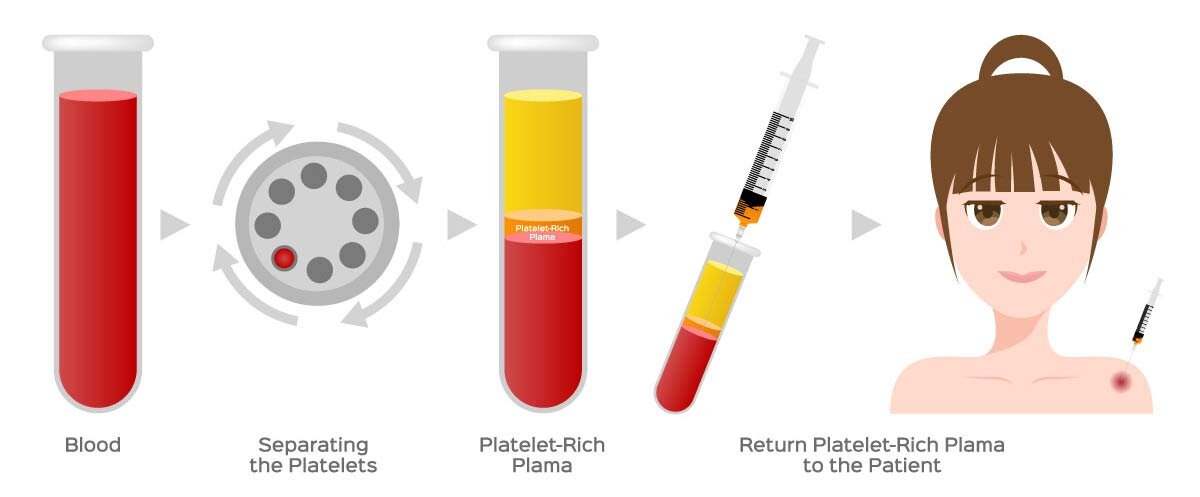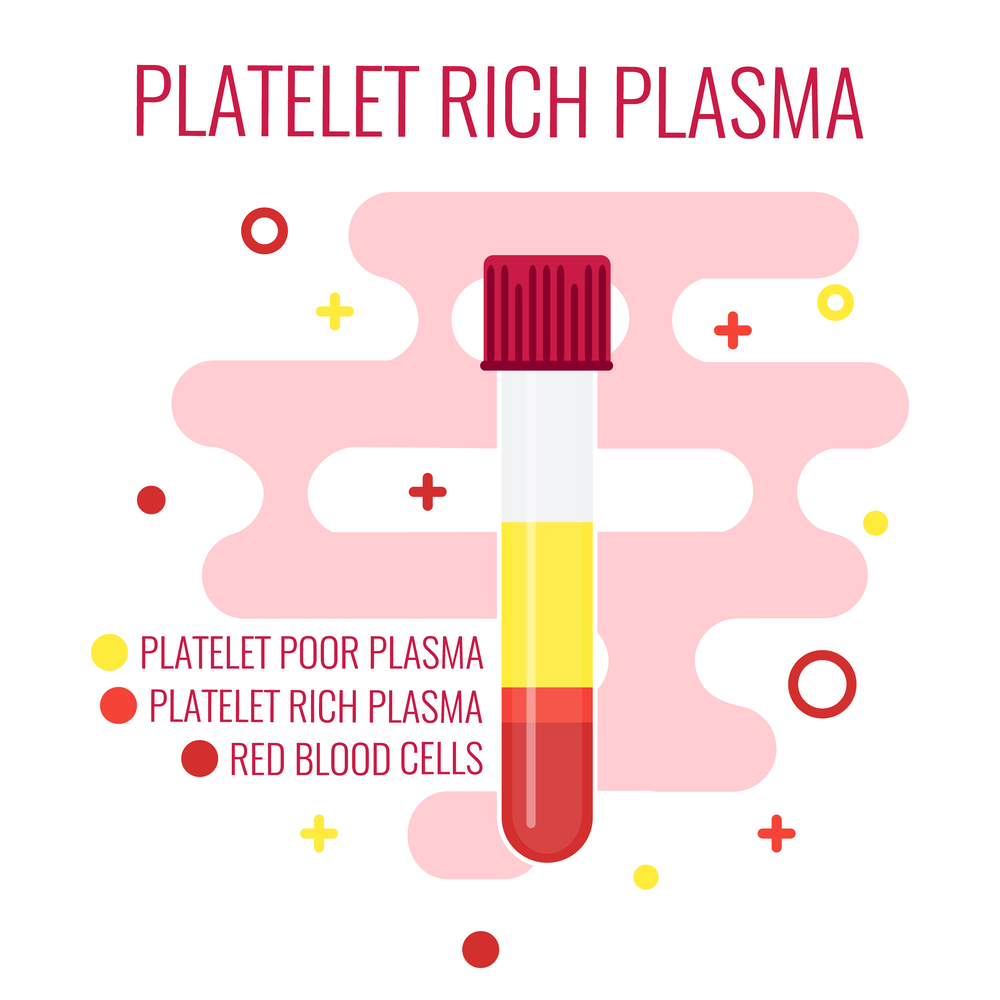What is Platelet-Rich Plasma (PRP) Therapy?
Platelet-rich plasma (PRP) therapy uses injections of a concentration of a patient's own platelets to accelerate the healing of injured tendons, ligaments, muscles and joints. In this way, PRP injections use each individual patient's own healing system to improve musculoskeletal issues and conditions.
Plasma is the liquid part of your blood that is mostly made of water and protein. Plasma allows red and white blood cells and platelets move through your bloodstream. Platelets are a type of blood cell that makes your blood clot. Platelets are tiny, disc-shaped cells in the bloodstream. They serve as the body’s fixers, forming blood clots when there is an injury. When an injury activates them, platelets go to work, form blood clots, and rapidly release growth factor proteins to start the healing process. These proteins signal cells in the injured area to grow, differentiate, produce new blood vessels, and lay down fibrous tissue to repair the damage.
Platelet-rich plasma therapy involves drawing blood from the patient and spinning it in a centrifuge. This process separates the red blood cells and most of the white blood cells from the blood plasma, which consists of water, electrolytes, proteins, and platelets. The platelet-rich plasma separates from other blood components and returns to an injured part of the body through an injection. The platelets are often activated before injection, meaning the clotting process is artificially started before the platelets are introduced to the injured area. When activated, the platelets immediately start to clot and produce growth factor hormones that start healing the affected area.
The Process
To collect plasma, a doctor draws blood from your body and uses a machine (centrifuge) to separate the platelet-rich plasma from the rest of the blood. Then the doctor numbs the area of your body being treated with PRP injections. Once you’re numb, the doctor uses a needle to inject your plasma into the area of your body being treated.
Conditions Treated with PRP Injections
At Aptiva Health, PRP injections are most commonly us for joint and tendon tears, tendonitis, musculoskeletal injuries, arthritis-related pain, and other joint injuries. We specialize in promoting functional movement and generating tissue health, which is why PRP plays a major role in many of our injection protocols. PRP injections provide an alternative to some orthopedic surgeries.
Sports Injuries
Whether you rolled an ankle playing basketball or took a bad tackle to the knee, a PRP injection can work wonders for your joints and ligaments. Joint injuries can cause prolonged pain and discomfort if left untreated. By injecting PRP into the joint, our sports medicine specialists promote the healing of individual ligaments and generally improve the range of motion and comfort of the entire joint.
Damaged Muscles
If you suffered a muscle tear, PRP therapy can reduce your recovery time and promote quicker recovery from the affected muscle. Whether you were hurt lifting weights or from a hyperextension playing sports, your outcome can be vastly improved with PRP.
Arthritis
Recent studies have claimed that PRP should be the first line of defense against arthritis of all types. Osteoarthritis, the most common form, has remained troublesome to treat. There is no cure for arthritis, and most treatments are palliative in nature. PRP may provide a safe and lasting treatment option for patients suffering from arthritis-related pain.
Tendonitis
Damaged tendons can be difficult to treat due to their hypovascular nature (meaning they do not get very much blood flow). The science is persuasive that PRP injections are a highly successful treatment for tendon injuries (tendinopathy). These include tennis elbow (epicondylitis), rotator cuff injuries, “jumper’s knee” (patellar tendonitis), Achilles tendonitis, plantar fasciitis, and tendinosis, among others. The success rate of PRP injections for resolving these conditions is very high.
Surgery
More recently, PRP has been used during certain types of surgery to help tissues heal. It was first thought to be beneficial in shoulder surgery to repair torn rotator cuff tendons. Recent research has been dedicated to the benefit of PRP in meniscus healing after meniscus repair; however, these studies are only in their infancy. Surgery to repair torn knee ligaments, especially the anterior cruciate ligament (ACL) is another area where PRP has been applied. Research is continuing to develop on the efficacy of PRP administration during surgery.
What to expect after PRP injections
Platelet-rich plasma injections into a joint, muscle, or tendon will require some recovery time. As mentioned, PRP does not fix the problem or relieve symptoms but instead begins and accelerates a natural regenerative process. That healing process will take several weeks or months to complete, but the treatment area will be painful and probably swollen for the first few days. In fact, swelling is part of the initial healing process.
Recovery time and limitations
In general, PRP injection recovery time is one to two days of rest and up to two weeks with walking support (i.e., crutches), after which physical therapy will begin.
Some PRP treatments will allow patients to return to work the next day. Others will require one or two days of rest. Avoid exercise and keep activities that use the affected area down to a minimum. If you have had an injection into your hip, knee, or ankle, avoid walking during this time. Depending on the injection, a patient may need to use a sling, walking boot, or crutches for anywhere from a few days to two weeks.
Although the area treated may swell, anti-inflammatory medications, such as steroids or NSAIDs, should be avoided for at least a week. Your physician may prescribe pain relievers that also are not anti-inflammatory.
Any physical therapy will begin about two weeks after the treatment. For joint, muscle, or tendon treatment, the healthcare provider will want a follow-up visit in six to eight weeks to assess progress. The pain will gradually subside over the following weeks and months.
Side effects
Platelet-rich plasma therapy uses blood from the patient, so it’s remarkably safe and free from side effects. The only side effects people may experience are temporary injection site reactions. Local site reactions such as nerve injury, tissue damage, or local pain are from the injection itself. There is a small risk of infection as there is with all injections.




